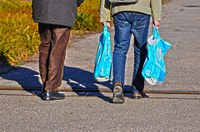Prairie Fare: Consider using reusable grocery bags more often
(Click an image below to view a high-resolution image that can be downloaded)
I noticed a plastic bag high in the tree outside my home. I wanted to hire a squirrel to get it out of the tree. Squirrels are not very helpful, unfortunately.
As we drove around doing errands, I was tuned into the presence of plastic bags. I saw plastic bags trapped in bushes and against fences and buildings. I saw other trash, too, but that’s another story.
When I arrived home with a few bags of groceries, I was happy I had remembered to bring reusable bags to carry our groceries to the car.
I have too many plastic bags. I have a “bag of bags” in my closet.
I do not think I am the only person that amasses plastic bags.
On average, we each collect 365 plastic bags per year according to information from the Center for Biological Diversity.
At least 500 cities and 20 states have banned plastic bags. What’s the big deal with plastic bags?
Unfortunately, plastic does not break down easily. Some estimate that plastic bags may take 20 years to decompose. Plastic can be a danger to animal and aquatic life that may become trapped in the plastic.
Animals and fish might see plastic as food. Further, animals and fish become food for many of us. Plastic, anyone?
Plastic bags have many uses. We can certainly reuse plastic bags for trash or other things, so that lessens the impact.
Sometimes, I just carry the grocery item out of the store without a bag or in my grocery cart. I am aware of my ample supply of plastic bags at home, which make me feel a bit guilty.
We can bring our plastic bags to the bag-recycling bin at the grocery store if available. Local thrift stores often are pleased to receive plastic bags to pack their items.
We can use reusable bags for all kinds of shopping. Keep in mind that reusable cloth bags could also pose some food safety risks.
Scientists have been thinking about reusable bags for quite some time. In 2013, food scientists collected reusable bags in California and Arizona and tested them for E. coli. In their published report, they noted that 12% of the bags contained this dangerous type of bacteria.
The researchers also tested the number of bacteria that grew after the bags were stored in trunks in hot weather. The number of bacteria multiplied by 10 in just two hours.
Since that study and other research, some best practices for reusable bags have been provided to consumers. If you use reusable cloth bags for groceries, be sure to avoid cross-contamination and reduce your risk.
- Use food bags for food only. Consider color-coding your reusable grocery bags. Use green bags for produce and red bags for meat and other proteins. You probably want to place the meat in the plastic bags near the meat case to avoid the risk of contaminating other foods in your cart and in your bag. (Then reuse the plastic bags to wrap trash or pick up after pets.)
- When you set reusable bags down in your kitchen, think about where you are placing the bags. For example, avoid setting the bags on the surface of the parking lot and then stuffing the bags inside of each other.
- Wash cloth reusable bags with hot, soapy water.
We can think about “repurposing” in our kitchens if we have leftover foods after a meal. To avoid wasting food, think of leftovers as planned-overs.
If you have planned-over whole roast chicken: Shred it, add some mayonnaise and chopped celery, and use it to make sandwiches. Add some salsa and use it for chicken tacos. Simmer it with barbecue sauce and make sandwiches. Make some chicken-vegetable soup.
If you have planned-over spaghetti sauce with meat: Use it to make lasagna or homemade pizza, or freeze it for a quick dinner later.
If you have planned-over roast beef: Use it to make soup, stew or stir-fry. Shred it, add some barbecue sauce and serve it on buns.
Here is a recipe to make use of planned-over chili that you might have in your refrigerator.
Planned-over Taco Salad
Leftover chili, recipe of choice (or use 15- to 16-ounce can chili)
½ head lettuce
8 ounces grated cheddar cheese
1 tomato, chopped
4 cups baked tortilla chips or corn chips
Salsa
Heat chili. On each of four plates, place 1 cup chips. Top with chopped lettuce, one-fourth of the chili, grated cheese and chopped tomatoes. Serve with salsa on the side.
The nutritional value will vary depend on the ingredients you use.
(Julie Garden-Robinson, Ph.D., R.D., L.R.D., is a North Dakota State University Extension food and nutrition specialist and professor in the Department of Health, Nutrition and Exercise Sciences.)
NDSU Agriculture Communication – March 21, 2024
Source: Julie Garden-Robinson, 701-231-7187, julie.garden-robinson@ndsu.edu
Editor: Elizabeth Cronin, 701-231-7006, elizabeth.cronin@ndsu.edu




